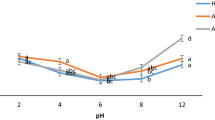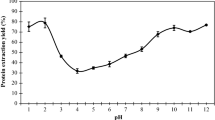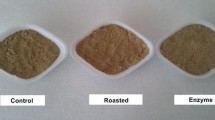Abstract
Protein extracts from edible insects have not been exploited fully in product development due to limited information on extraction and functionality of the protein extracts. Therefore there was a need to evaluate the effect of selected protein extraction methods on the physico-chemical characteristics and functional properties of extracted proteins. Farmed edible crickets were obtained from JKUAT farm in Kenya, freeze dried and ground to powder. The proteins were extracted using two methods namely; hexane and aqueous extraction. Yield was determined gravimetrically and colour by colourimetric method. The crude protein, crude fibre, crude fat, crude ash and available carbohydrates were determined using standard analytical methods. Protein digestibility was determined using enzymatic digestion methods while protein fractions were extracted and quantified gravimetrically. The water holding capacity was determined using standard AACC procedure. Emulsion capacity and stability, foaming capacity and foam stability were also investigated. HE recorded the highest yield. Lightness and hue angle were significantly affected by the extraction method with hexane extraction recording higher values compared to aqueous extraction (P < 0.0001, P = 0.0003). The proximate components except crude fiber were affected by the extraction method. Aqueous extraction recorded significantly higher values for globulin (19.42%), prolamin (6.26%) and glutelin (10.10%) (P < 0.0001). There was no significance difference in water holding capacity and oil adsorption capacity. However AE precipitate recorded higher values for emulsion capacity (41.70%), emulsion stability (33.61%), foaming capacity (11.11%) and foam stability (10.15%). Extraction methods had an effect on physio- chemical and functional characteristics of the protein concentrates.



Similar content being viewed by others
References
A. van Huis, Potential of insects as food and feed in assuring food security. Annu. Rev. Entomol. 58, 120928130709004 (2011). doi:10.1146/annurev-ento-120811-153704
FAO/WHO, Development of regional standard for Edible Crickets and their products:report of a joint FAO/WHO coordinating committee for Asia (Session 17) (2010)
L. Yi, C.M. Lakemond, L.M. Sagis, V. Eisner-Schadler, A. van Huis, M.A. van Boekel, Extraction and characterisation of protein fractions from five insect species. Food Chem. 141, 3341–3348 (2013). doi:10.1016/j.foodchem.2013.05.115
L. Capinera, Encyclopedia of Entomology, vol. 3 (Kluwer Academic Publishers, London, 2004)
D. Renault, A. Bouchereau, Y.R. Delettre, F. Hervant, P. Vernon, Changes in free amino acids in Alphitobius diaperinus (Coleoptera: Tenebrionidae) during thermal and food stress. Comp. Biochem. Physiol. 143, 279–285 (2006). doi:10.1016/j.cbpa.2005.11.012
D. Barker, M.P. Fitzpatrick, E.S. Dierenfeld, Nutrient composition of selected whole invertebrates. Zoo Biol. 134, 123–134 (1998)
Mark, D. Finke, Gene RDAJB Use of a four-Parameter logistic model to evaluate the quality of the protein from three insect species when Fed to Rats1. Entomol.-meat Anim. Sci. 119, 864–871 (1989)
B.A. Rumpold, O.K. Schlüter, Nutritional composition and safety aspects of edible insects. Mol. Nutr. Food Res. 57, 802–823 (2013). doi:10.1002/mnfr.201200735
B.A. Rumpold, O.K. Schl, Nutritional composition and safety aspects keywords. Mol. Nutr. Food Res. 57(5), 802–823 (2013). doi:10.1002/mnfr.201200735
A.L. Yen, Entomophagy and insect conservation: some thoughts for digestion. J. Insect Conserv. 13, 667–670 (2009). doi:10.1007/s10841-008-9208-8
F.R. Valle, M.H. Mena, H. Bourges, An investigation into insect protein. J. Food Process Preserv. 6, 99–110 (1982). doi:10.1111/j.1745-4549.1982.tb00645.x
E.E. Babiker, A.B. Hassan, M.M. Eltayeb, Solubility and functional properties of boiled and fried sudanese tree locust flour as a function of NaCl concentration. J. Food Technol. 5, 210–214 (2007)
L. L’hocine, J.I. Boye, Y. Arcand, Composition and functional properties of soy protein isolates prepared using alternative defatting and extraction procedures. J. Food Sci. 71, C137–C145 (2006). doi:10.1111/j.1365-2621.2006.tb15609.x
A.P. Gandhi, K.C. Joshi, K. Jha, V.S. Parihar, D.C. Srivastav, P. Raghunadh, J. Kawalkar, S.K. Jain, R.N. Tripathi, Studies on alternative solvents for the extraction of oil-l soybean. Int. J. Food Sci. Technol. 38, 369–375 (2003). doi:10.1046/j.1365-2621.2003.00683.x
P. Hernández-Muñoz, E. Almenar, V.V. Del, D. Velez, R. Gavara, Effect of chitosan coating combined with postharvest calcium treatment on strawberry (Fragaria × ananassa) quality during refrigerated storage. Food Chem. 110, 428–435 (2008). doi:10.1016/j.foodchem.2008.02.020
E.T. Mertz, M.M. Hassen, C. Cairns-Whittern, A.W. Kirleis, L. Tu, J.D. Axtell, Pepsin digestibility of proteins in sorghum and other major cereals. Proc. Natl. Acad. Sci. 81, 1–2 (1984). doi:10.1073/pnas.81.1.1
S. Agboola, D. Ng, D. Mills, Characterisation and functional properties of Australian rice protein isolates. J. Cereal Sci. 41, 283–290 (2005). doi:10.1016/j.jcs.2004.10.007
M. Naczk, L.J. Rubin, F. Shahidi, Functional properties and phytate content of pea protein preparations. J. Food Sci. 51, 1245–1247 (1986)
AACC, AACC method 56-30 water hydration capacity of protein materials AACC method 56-30 water hydration capacity of protein materials (continued) 3–4 (2000)
M.J.Y. Lin, E.S. Humbert, Certain functional properties of Sunflower meal products. J. Food Sci. 39, 5–7 (1974)
C.W. Coffmann, V.V. Garcia, Functional properties and amino acid content of a protein isolate from mung bean flour. J. Food Technol. 1, 473–484 (1977)
P.J. Wittkopp, P. Beldade, Development and evolution of insect pigmentation: genetic mechanisms and the potential consequences of pleiotropy. Semin. Cell Dev. Biol. 20, 65–71 (2009). doi:10.1016/j.semcdb.2008.10.002
H.W. Kim, D. Setyabrata, Y.J. Lee, O.G. Jones, Y.H.B. Kim, Pre-treated mealworm larvae and silkworm pupae as a novel protein ingredient in emulsion sausages. Innov. Food Sci. Emerg. Technol. 38,116–123 (2016). doi:10.1016/j.ifset.2016.09.023
W.C. Stancil, D. Jordan, Color control from perception to instrumentation, in Precise Color Communication, (Minolta cop., New Jersey, 1985), pp 33–35
M.R. Yeomans, L. Chambers, H. Blumenthal, A. Blake, The role of expectancy in sensory and hedonic evaluation: the case of smoked salmon ice-cream. Food Qual. Prefer. 19, 565–573 (2008). doi:10.1016/j.foodqual.2008.02.009
HSG Tan, ARH Fischer, P. Tinchan, M. Stieger, LPA Steenbekkers, HCM van Trijp, Insects as food: exploring cultural exposure and individual experience as determinants of acceptance. Food Qual. Prefer. 42, 78–89 (2015). doi:10.1016/j.foodqual.2015.01.013
D.A. Tzompa-Sosa, L. Yi, HJF van Valenberg, MAJS van Boekel, CMM Lakemond, Insect lipid profile: aqueous versus organic solvent-based extraction methods. Food Res. Int. 62, 1087–1094 (2014). doi:10.1016/j.foodres.2014.05.052
M.D. Finke, Complete nutrient composition of commercially raised invertebrates used as food for insectivores. Zoo Biol. 21, 269–285 (2002). doi:10.1002/zoo.10031
V. Jayasena, H.J. Chih, S. Nasar-Abbas Functional properties of sweet lupin protein isolated and tested at various pH levels. Res. J. Agric. Biol. Sci. 6, 130–137 (2010)
E.N. Videan, J. Fritz, J. Murphy, Development of guidelines for assessing obesity in captive chimpanzees (Pan troglodytes). Zoo Biol. 26, 93–104 (2007). doi:10.1002/zoo
S. Koide, Chitin-chitosan properties, benefits and risks. Nutr. Res. 18, 1091–1101 (1998)
A.D. Banjo, O.A. Lawal, E.A. Songonuga, The nutritional value of fourteen species of edible insects in southwestern Nigeria. African. J. Biotechnol. 5, 298–301 (2006). doi:10.5897/AJB05.250
J.N. Kinyuru, G.M. Kenji, S.M. Njoroge, M. Ayieko, Effect of processing methods on the in vitro protein digestibility and vitamin content of edible winged termite (Macrotermes subhylanus) and grasshopper (Ruspolia differens). Food Bioprocess Technol. 3, 778–782 (2010). doi:10.1007/s11947-009-0264-1
J. Ramos-Elorduy, J.M.P. Moreno, E.E. Prado, M.A. Perez, J.L. Otero, O. Ladron De Guevara, Nutritional value of edible insects from the State of Oaxaca, Mexico. J. Food Compos. Anal. 10, 142–157 (1997). doi:10.1006/jfca.1997.0530
C.E. Bodwell, L.D. Satterlee, L.R. Hackler, Protein digestibility of the same protein preparations by human and rat assays and by in vitro enzymic digestion methods. Am. J. Clin. Nutr. 33, 677–686 (1980)
S. Belluco, C. Losasso, M. Maggioletti, C.C. Alonzi, M.G. Paoletti, A. Ricci, Edible insects in a food safety and nutritional perspective: a critical review. Compr. Rev. Food Sci. Food Saf. 12, 296–313 (2013). doi:10.1111/1541-4337.12014
J. Mitsuhashi, Insects as traditional foods in Japan. Ecol. Food Nutr. 36, 187–199 (1997). doi:10.1080/03670244.1997.9991514
R. Akpossan, Y. Digbeu, M. Koffi, J. Kouadio, E. Dué, P. Kouamé, Protein fractions and functional properties of dried Imbrasia oyemensis larvae full-fat and defatted flours. Int. J. Biochem. Res. Rev. 5, 116–126 (2015). doi:10.9734/IJBCRR/2015/12178
E.D. Aguilar-Miranda, M.G. Lopez, C. Escamilla-Santana, A.P. Barba de la Rosa, Characteristics of maize flour tortilla supplemented with ground Tenebrio molitor larvae. J. Agric. Food Chem. 50, 192–195 (2002). doi:10.1021/jf010691y
A. Yemisi, K.O.A. Adebowalea, MOO, Evaluation of nutritive properties of the large African Cricket (Gryllidae sp). Pak. J. Sci. Ind. Res. 48, 274–278 (2005)
S. Bußler, B.A. Rumpold, E. Jander, H.M. Rawel, O.K. Schlüter, Recovery and techno-functionality of flours and proteins from two edible insect species: meal worm (Tenebrio molitor) and black soldier fly (Hermetia illucens) larvae. Heliyon 2, e00218 (2016). doi:10.1016/j.heliyon.2016.e00218
X. Zhao, J.L. Vazquez-Gutierrez, D.P. Johansson, R. Landberg, M. Langton, Yellow mealworm protein for food purposes—extraction and functional properties. PLoS ONE 11, 1–17 (2016). doi:10.1371/journal.pone.0147791
A. Naik, S.N. Raghavendra, K.S.M.S. Raghavarao (2012) Production of coconut protein powder from coconut wet processing waste and its characterization. Appl. Biochem. Biotechnol. 167, 1290–1302. doi:10.1007/s12010-012-9632-9
A.I. Osasona, O. Olaofe, Nutritional and functional properties of Cirina forda larva from Ado-Ekiti, Nigeria. Afr. J. Food Sci. 4, 775–777 (2010)
H.A. Al-Kahtani, A.A. Abou-Arab, Comparison of physical, chemical and functional properties of Moringa peregrina and soybean proteins. Cereal Chem. 70, 619–626 (1993)
B.E. Chove, A.S. Grandison, M.J. Lewis, Some functional properties of fractionated soy protein isolates obtained by microfiltration. Food Hydrocoll. 21, 1379–1388 (2007). doi:10.1016/j.foodhyd.2006.10.018
K. Lomakina, K. Mikova, A Study of the factors affecting the foaming properties of egg white—a review. Czech. J. Food Sci. 24, 110–118 (2006)
Acknowledgements
I would like to thank Jomo Kenyatta University of Agriculture and Technology Research, Production and Extension department (JKUAT-RPE) for funding this project and the department of Food Science and Technology JKUAT for providing facilities and technical support.
Author information
Authors and Affiliations
Corresponding author
Rights and permissions
About this article
Cite this article
Ndiritu, A.K., Kinyuru, J.N., Kenji, G.M. et al. Extraction technique influences the physico-chemical characteristics and functional properties of edible crickets (Acheta domesticus) protein concentrate. Food Measure 11, 2013–2021 (2017). https://doi.org/10.1007/s11694-017-9584-4
Received:
Accepted:
Published:
Issue Date:
DOI: https://doi.org/10.1007/s11694-017-9584-4




